10 Ornamental Trees to Grow in Oregon
Many ornamental trees thrive in Oregon. These trees that stay under 40 feet have something unique about them, making them more attractive than the average tree. It could be that they flower, fruit, or something different about their bark. People living in Oregon will want to consider these 10 ornamental trees.
Oregon Sunset Japanese Maple (Acer palmatum ‘Oregon Sunset’)
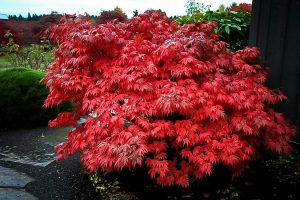
The Oregon sunset Japanese maple tree is a slow-growing tree that can be planted directly in the ground or grown in a container. It will be about 4 feet tall in five years and 10 feet tall in 10 years, and this multi-trunk tree will be as broad or broader as it is tall. This tree produces vivid plum-colored foliage in the spring. The leaves turn more of a burgundy color during the summer before transitioning to crimson and orange in the fall. The leaves have five to seven lobes that are acutely pointed. This tree also puts on winged samara consisting of two seeds forming a boomerang shape. These seeds are red during the growing season and turn brown in the autumn before eventually falling off the tree.
This tree can be planted in the shade or in full sun, but its coloring will be more vivid if it can get some afternoon sun. This tree needs to be kept consistently moist and prefers neutral soil. This tree will naturally eliminate branches that do not get enough sunlight, but landscapers can also prune it to their desired shape.
Pacific Dogwood (Cornus nutalii)
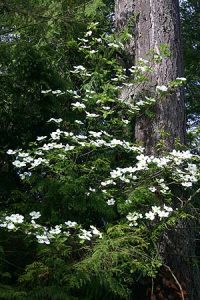
Pacific dogwoods grow to be about 25 feet tall. While this tree appears to have large flowers in the spring, the flowers consist of clusters of flowers surrounded by four to six white bracts that may have a pinkish tinge. The flowers appear at the end of this plant’s stems. The Pacific dogwood blooms in the spring and, depending on the weather, may re-bloom in the fall. This tree also has clusters of leaves near the end of its branches, which are 4 inches long. Each leaf is wedge-shaped at its base and has a pointed tip. Many of these simple leaves are tinged with a red color that becomes more pronounced in the fall.
This tree does best when planted within 200 miles of the Pacific Ocean. It is one of the few ornamental trees that do well in the shade. This tree prefers well-drained soil that is rich in organic matter.
Golden Raindrops Flowering Crabapple (Malus transitoria Golden Raindrop)
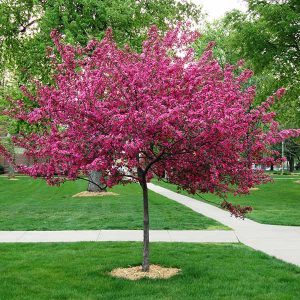
Golden raindrops flowing crabapple is an elegant tree that grows to be about 20 feet tall. It has an elegant vase-like shape with horizontal branches. This tree puts on hundreds of pink buds in the early spring, which white flowers emerge from mid-spring. This flowering crabapple tree has a naturally open form. Its dark-green leaves are deeply cut and about 1.25 inches long. They turn yellow with a tinge of red in the fall. This tree may even have some purple fall leaves, depending on the weather. The abundant fruit on this tree is about ¼ inch in diameter. While this tree will appear very upright when young, it takes on a rounder form as it ages.
This tree is very disease and insect-resistant. Animals love to eat the ripe fruit. Plant this tree in full sun to get the most flowers and fruit. It prefers well-drained soil.
Whitebeam Mountain Ash (Sorbus aria ‘Lutescens’)
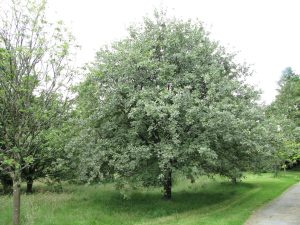
Whitebeam is a pyramid-shaped ornamental tree that grows to be about 40 feet tall. This tree has smooth silver bark, which creates a beautiful contrast with its dark-green leaves that have a silvery tint to their underside. The glossy leaves turn bright orange in the fall. In the spring, many white flowers appear in flat-top clusters on top of this tree’s branches. Each flower is about 1/3 inch across. They are quickly replaced by 2.5 inches long reddish-orange fruit. The ½-inch-diameter fruit has an oval shape that tapers slightly to form a point at the bottom. The fruit will remain on the tree until mid-winter if the birds do not pick it first.
Whitebeam mountain ash trees are adaptable to many soil types, including limestone. This tree loves the sun and well-drained soils. Avoid disease issues by pruning this tree in the late winter.
Newport Purple-leaf Plum (Prunus cerasifera Newport)
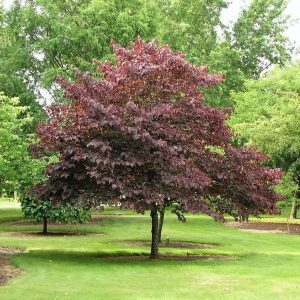
Newport purple-leaf plum trees, often called cherry plum trees, are gorgeous round trees that mature at about 20 feet. The foliage on this tree is bronze purple in the spring, deep purple in the summer and turns a reddish-purple in the autumn. It produces pale pink flowers in the spring that open from white blossoms early in the spring. The flowers have a single row of petals., and these fragrant flowers smother the tree’s bare branches. This variety does not produce as much fruit compared to some cherry plum trees. Hence, it is far less messy. The 1-inch-diameter fruit has a dark red color. If busted open, the flesh is light red.
This tree benefits from a bit of pruning after the flowers die in the spring. It grows best in full sun in loamy soils and likes to stay moist.
Japanese Snowbell
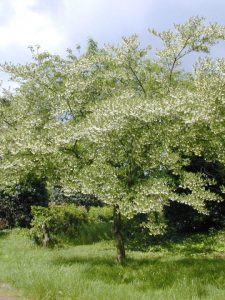 (Styrax japonicus)
(Styrax japonicus)
The Japanese snowbell tree grows naturally to be about 30 feet tall, but it can be pruned smaller. This tree has a vase-shape when young, which becomes more rounded as the tree ages. Hundreds of white bell-shaped flowers appear from strongly horizontal branches in late spring. Each sweetly fragrant flower is approximately ½-inch wide and has yellow stamens. They grow on the ends of pendulous stalks about 1.3 inches long. After the flowers fade in June, this tree produces gray drupe fruit that stays on the tree through mid-winter. This tree has glossy green oblong leaves that remain small and turn shiny yellow once temperatures begin to drop in autumn. Once winter sets in, the fissures in this tree are particularly stunning because the inner bark is bright orange.
This hardy tree prefers the sun but can handle a little shade. It needs to be protected from strong winds, and it loves organically rich, well-drained soil.
Snow Fountain Weeping Cherry (Prunus’ Snow Fountain’)

Snow fountain weeping cherry trees grow to be about 15 feet tall, and as the name suggests, they have a weeping appearance. In the early spring, pink buds appear on the branches. They are followed by white flowers, giving this tree a frozen water fountain-like formation. The fragrant blossoms that last for about three weeks are very attractive to birds and butterflies. Then, dark-green leaves that grow to be approximately 2 inches long emerge in the spring and stay throughout the summer months. Once autumn arrives, the leaves turn vibrant golden-yellow and orange. This tree also produces hundreds of black pea-size fruits in the summer that stay on the tree long into winter. The fruit is inedible.
While this ornamental tree will survive when provided a little shade, it produces best when planted in full sun and likes to be kept consistently moist.
Serviceberry (Amelanchier alnifolia)

The serviceberry tree is an Oregon native growing to about 30 feet tall. While it often grows naturally as a shrub, it can be easily pruned as a small tree. This ornamental tree produces five-petal white flowers in the spring. The flowers that are about 3 inches long grow on drooping racemes, which can be up to 7 inches long and contain up to 14 individual flowers. The flowers last for about three weeks before they are replaced with round fruit that changes colors from green to red before finally becoming purplish-black when ripe. While the fruit starts small, it will mature to be about 3/8 inches in diameter. The fruit can be eaten raw or made into jellies and pies.
This tree, a member of the rose family, adapts well to many soil types. It performs best when planted in full sun but will grow with some shade. Serviceberry trees will grow in wet areas, but they do not like to be left standing in water for a long time.
Trompenburg Japanese Maple (ACER PALMATUM X SHIRASAWANUM ‘TROMPENBURG’)
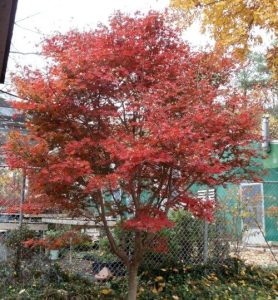
Japanese maples can easily be pruned to be a single-stem tree. When left natural, most grow with multiple trunks. Most grow to be less than 25 feet tall and spread as wide as they are tall. In the late spring, small clusters of umbrella-shaped flowers appear. The flowers are inconspicuous, but they are followed by samara, each about ½ inch long. As the summer progresses, samaras turn from green to red. While there are at least 17 types of Japanese maple trees, the Trompenburg is a favorite because its hand-like leaves are a burgundy red throughout the spring and summer before turning a scarlet red in the fall.
Trompenburg Japanese maple trees love well-drained soil. This subspecies can handle full sun, but it does best with a bit of shade. It may need some wind protection until mature.
Chinese Fringetree (Chionanthus retusus)
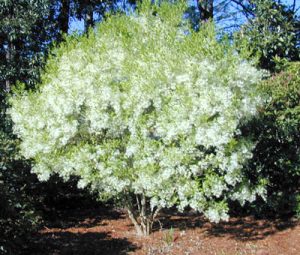
The Chinese fringetree matures to be about 25 feet tall and has a wide-branching habit. Towards mid-spring, this tree puts on white flowers with four strap-like petals about 1 inch long. Following the flowers fading in early summer, female Chinese fringetrees develop fruit that is 3/8- to ½-inch-long bluish drupes. This tree’s fruit is not edible by humans but may help attract wildlife to landscaping. The leaves on this fringetree are elliptical to ovate and can be up to 8 inches long. They are dark green in the spring and summer, turning pale yellow in autumn before dropping in the winter. The bark on this tree adds visual interest because of the grayish rough trunk texture compared to the smoother and lighter-colored twig texture, so this tree is pretty, even in the winter.
Like most Oregon ornamental trees, this fringetree prefers at least six hours of sun daily. It will adapt to many soil types and likes to be kept moist.
Red Dragon Hazelnut (Corylus avellana L ‘Red Dragon’)
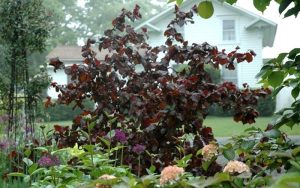
While red dragon hazelnut trees can mature to be about 20 feet tall, most stay about 12 feet tall. Unlike some hazelnut trees, this variety produces male and female flowers on the same tree. Burgundy catkins about 2 inches long hang below the bare branches before the leaves emerge in the spring. These flowers are often cut and used in ornamental bouquets. The grayish-green leaves that grow to be about 4 inches long emerge mid-spring, and these round crinkled leaves turn bright red in the autumn. After the flowers fade, the nuts appear in clusters of one or two. These nuts that have a bitter flavor stay very small. This tree has rough textured bark, which grows very contorted limbs and twisting shoots, so it looks interesting, even when bare in the winter.
Red dragon hazelnut trees like well-drained soil that is pH neutral. Unlike many hazelnut trees, this tree is resistant to blight.
When choosing an ornamental tree in Oregon, consider these choices carefully. They each add beauty to the landscape.


